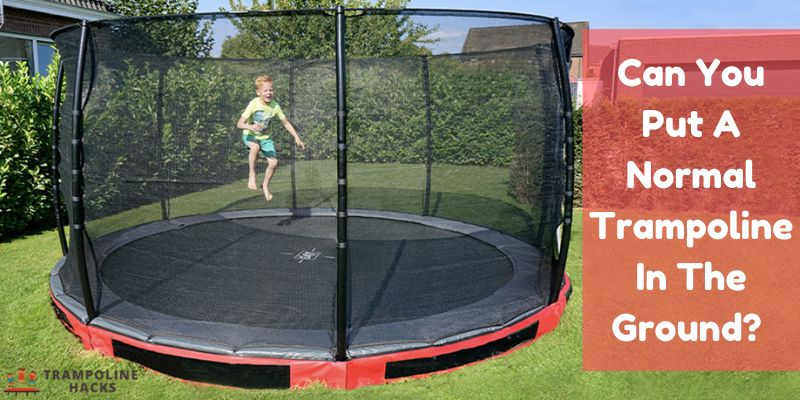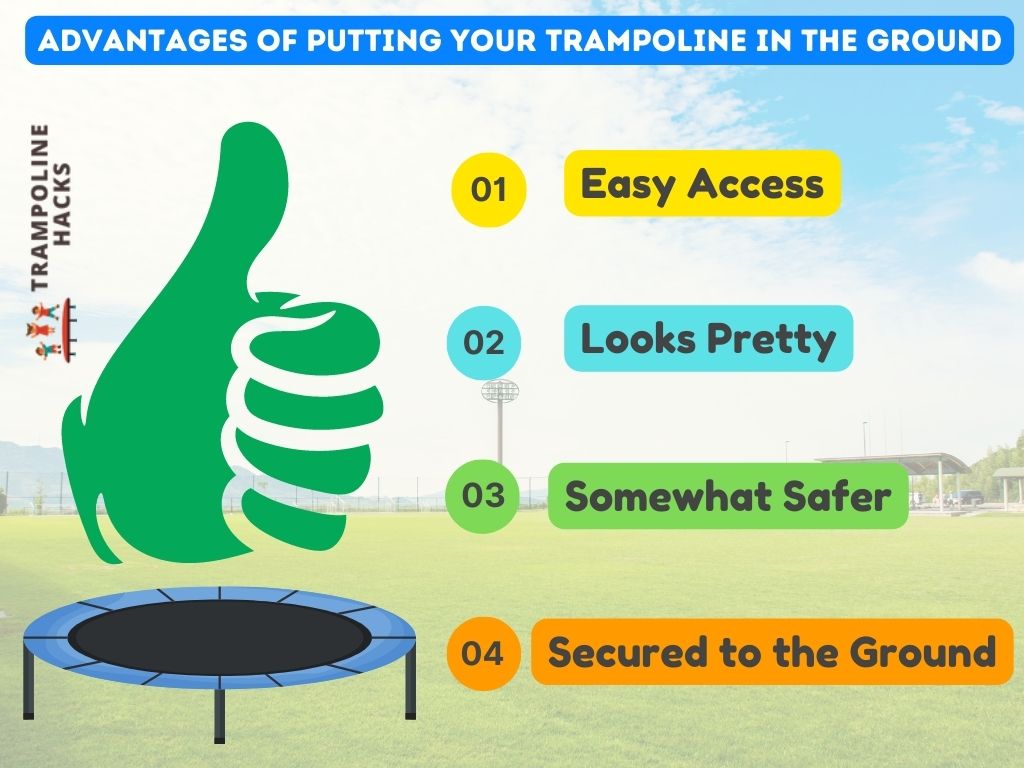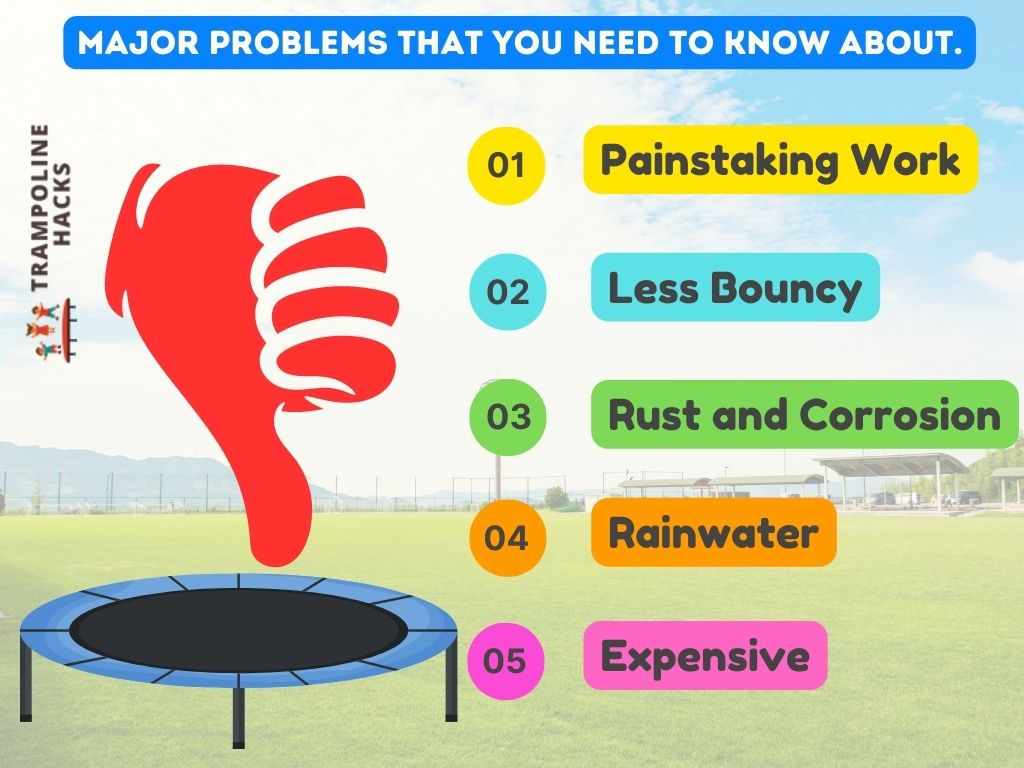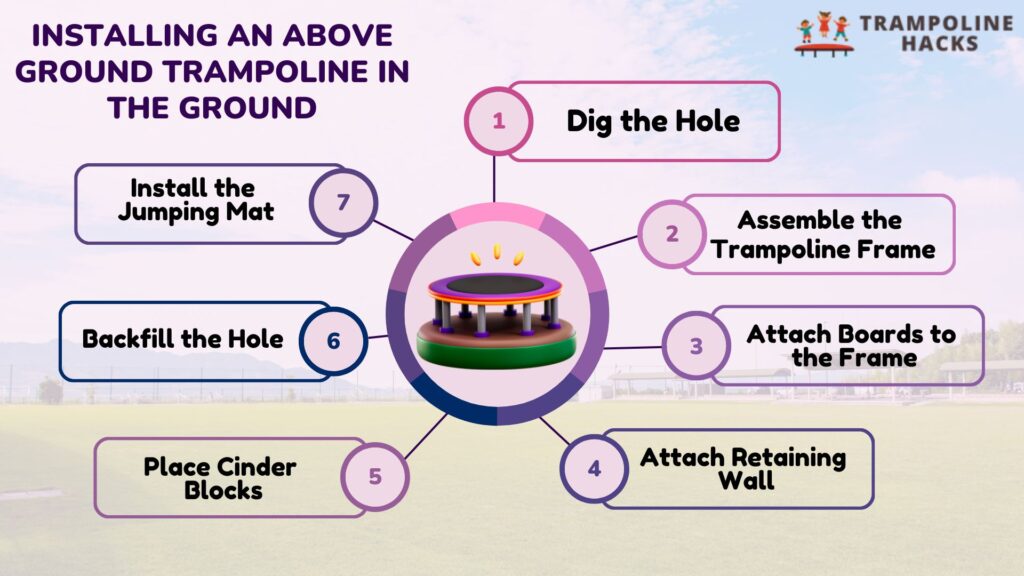Can You Put A Normal Trampoline In The Ground? [Is It A Good Idea?]
To sink or not to sink your trampoline – this has been the age-old question for most trampoline owners. And I don’t blame them, to be honest. In-ground trampolines, when installed properly, can drastically enhance the look of your backyard. And if your regular old above-ground trampoline can be put to the ground, why not just do it?
Though the idea might seem simple on paper, the truth is, sinking a normal trampoline in the ground does more harm than good. Sure, it will work to some extent. But your trampoline will not last very long, and the work that you have to do to get it installed is hardly worth the trouble.
- But what exactly are the issues here?
- Is there any way to install it without too much hassle?
- And what exactly do you have to do if you still want to go through with it?

If you are a relatively new trampoline owner or have less experience, it is natural to have these questions. And I am here to answer all of them.
Check can you have a trampoline without a fence
I will show you why installing a normal trampoline in the ground might not be a good idea, and also give you a couple of tips to install it anyways. So, whether you want to do it or not after reading the article is entirely in your hands.
What are the Pros and Cons of Putting a Normal Trampoline in the Ground?
Before I run you through the installation process, let’s take a step back. You already saw me preach against it, and you obviously deserve to know why I stand against this idea.
Yes, there are a couple of benefits to installing a normal trampoline in the ground, and even I have to admit that it looks better than an average trampoline. But the drawbacks of going through it far outweigh the benefits.
Before I get to the drawbacks, though, let me talk a bit about some of the advantages of putting your trampoline in the ground.

1. Easy Access
The biggest benefit of sinking your regular trampoline to the ground is that it is easy to access, especially for the kids. An above-ground trampoline is not that high for an average adult, but small kids require a ladder to climb on top of it. If you sink your trampoline to the ground, they can access it anytime they want.
Check Can you jump on trampoline with a hole in it
So, there’s little to no chance of your kids hurting themselves trying to climb.
2. Looks Pretty
A trampoline can make your landscape look astonishing or entirely break its aesthetics. Unfortunately, blending an above-ground trampoline with your backyard is more challenging, and if you do not execute it flawlessly, it can often look tacky.
However, if the trampoline is installed in the ground, it blends in much easier. In fact, most people would not even notice a trampoline installed on the ground at first glance.
3. Somewhat Safer
Since a sunken trampoline is closer to the ground, it is a bit safer compared to an above-ground trampoline. If someone jumps out of an above-ground trampoline, he is in for a world of hurt. But if the ground around the sunken trampoline is soft, you should be fine even if you fall out of the trampoline.
4. Secured to the Ground
If you live in a windy region, you may have heard of trampolines being blown away due to strong wind. Well, that is no longer a concern if your trampoline is sunk into the ground.
Yes, you can always anchor your above-ground trampoline using a couple of wooden stakes. Even when your trampoline is on concrete. But if it is installed in the ground, you never have to worry about it getting blown away.
Check can adults jump on trampolines
So, you see, I do get the appeal of trying to put a normal trampoline on the ground. But as I said, there are plenty of issues with it.
Here are a couple of major problems that you need to know about.

1. Painstaking Work
If you thought installing a normal trampoline in the ground was going to be easy, you are in for a rough awakening. Not only do you have to dig a hole deep enough to support the bouncing mat, but you also need to reinforce the walls inside the hole.
Even if you hire a professional contractor to do the digging for you, it will cost you a lot of money. And before you start digging, you might also need to get permission from your city office. Ultimately, installing a normal trampoline brings more hassle than it’s worth.
Check Can you wear shoes on a trampoline
2. Less Bouncy
If you install your normal above-ground trampoline in the ground, you will be sacrificing a lot of its bounciness. This is because above-ground trampolines are designed so that when you are jumping on the mat, air escapes from under it. When put in the ground, air will have no place to escape, and the bounce will take a drastic hit.
Even if you leave some openings around the trampoline for air to escape, it will feel stiffer. And a trampoline that does not bounce is no trampoline at all in my book. If you want a bouncy trampoline that is in the ground, it is better to just go with an in-ground trampoline.
3. Rust and Corrosion
A high-quality in-ground trampoline is designed to be installed on the ground. It comes with treated frames, legs, and springs that can withstand the heat and moisture that builds up under the trampoline mat. A typical sunken trampoline lasts you a couple of years without requiring maintenance.
While an above-ground trampoline may be fine if left under rain and sun, it can get rusty if you cut off air. The frame and springs of an above-ground trampoline are not designed to be in constant touch with moisture and dirt. And once it gets too corroded, it can break down while you are jumping on it.
Sure, you can replace the springs from time to time, but replacing the frame of the trampoline means buying a new one. So instead of paying for new trampolines every few months, it is cheaper to invest in a sunken trampoline in the first place.
4. Rainwater
Another reason why you do not want to transform a normal trampoline into a sunken one is rainwater. Water will start to fill up inside the hole during the rainy season. And you will not be able to use the trampoline until you get rid of it.
So, you need to install a drainage system or get a sump pump to pump the water out of the hole. Installing a normal trampoline inside the ground is expensive enough, and when you have to buy a separate sump pump for it, it is just not worth the trouble.
5. Expensive
The reason why most people want to use their average trampoline in the ground instead of buying a sunken trampoline in the first place is its cost. And I understand – in-ground trampolines typically cost thousands.
But installing a regular trampoline in the ground is not cheap either. When you add the cost of your above-ground trampoline digging supplies and also account for the time and energy that you put into installing it in the ground, you are actually spending more on it. It would be cheaper to buy an in-ground trampoline in the first place.
Can You Put an Above Ground Trampoline in the Ground?
I have given you a fair warning about installing an above-ground trampoline in the ground. But if you still want to go through with it, who am I to stop you? There are a couple of small details that you need to check before you can get started with the installation process, however.
Firstly, you want to check the size and shape of the trampoline. Typically, a round trampoline is easier to install as it takes up less space. You also want to take a look at the height of the trampoline’s legs. It will give you an idea of how deep a hole you need to dig.
Another thing you want to make sure of is that the color of the jumping mat is different from that of the grass. This is to make sure you can clearly spot the trampoline when you are walking around your yard. I also highly recommend installing some nightlights in your yard to prevent any accidents in the dark.
How Do You Put a Trampoline in the Ground?
If your trampoline meets all the requirements, we can get started with the installation steps. Get ready to put in a lot of elbow grease if you are taking this project on yourself. But if you can, it might be a better idea to hire a contractor who has experience with similar projects.
What Do You Need to Put a Trampoline in the Ground?
You need a basic set of digging supplies to put your trampoline in the ground. If you have a mechanical digger, the work can become a bit easier. In addition to digging tools, you also need some cinder blocks to place under the foot of the trampoline, along with some soft material to put under the trampoline.
Furthermore, you need a couple of 2×4 boards to reinforce the trampoline frame that will sit in the hole. 20 to 24 planks should do the trick. And to make the retaining frame, you need some sort of reinforcement. Sheet metal works well in this case.
You also want some masking tape and a measuring tape to measure out the frame length of the trampoline that you want to put in the ground. The masking tape will help you mark out the area that you have to dig inside.
If your trampoline is already assembled, now would be a good time to take the jumping mat apart. You want easy access to the trampoline frame so that you can attach reinforcements around it.
How Deep Do You Need to Dig for An Inground Trampoline?
As to this question, I cannot give you the exact answer, unfortunately. The depth of the hole depends entirely on the size of the trampoline. But in most cases, you need to make the hole three to five feet deep.
For the exact value, measure the length of the leg of your trampoline and add an extra couple of inches for the cinder blocks.
Installing an Above Ground Trampoline in the Ground

Here are the steps to installing your regular trampoline in the ground
1. Dig the Hole
The first step is to dig the hole. Take proper measurements and mark out the area where you need to dig. Using a shovel or a mechanical digger, dig as deep as you need. Set the top soil to the side as you can use it to fill the interior after installing the trampoline.
2. Assemble the Trampoline Frame
You want to assemble the frame of the trampoline without attaching the jumping mat. We will get to it later.
3. Attach Boards to the Frame
Take your 2×4 wooden boards and attach them around the trampoline frame. You want to make sure that it goes all the way around the frame and keeps the shape firm. The idea is to install two lines of wooden boards around the frame parallel to each other.
You can use screws, nails, or even wood glue to keep the boards joined with each other around the frame.
4. Attach Retaining Wall
The next step is to attach the retaining wall around the frame using sheet metal. If you are using sheet metal, place it around each section of the board and nail it into place.
5. Place Cinder Blocks
With the retaining wall installed, set the frame to one side. The next step is to place cinder blocks inside the hole where the frame legs will go. You want to make sure the trampoline sits on the cinderblock instead of the soft soil.
When the blocks are in place, set your trampoline frame on top of it. Secure it using extra cinder blocks or dirt.
6. Backfill the Hole
You want to use the dirt that you dug up before to secure the trampoline inside the hole perfectly. Make sure to fill around the retaining wall and that it stays firmly in place. Optionally, you can bury the footings along with the cinder blocks to keep it even more secure.
7. Install the Jumping Mat
When all is done and dusted, you are finally ready to install the jumping mat. Attach the springs and set up the jumping mat following the instructions in the owner’s manual.
Some Parting Wisdom
A sunken trampoline sure looks pretty, but transforming an above-ground trampoline into it is more trouble than it’s worth. Sure, in-ground trampolines are pricey, but they offer a safer and more reliable performance.
In the long run, getting an in-ground trampoline will cost less than installing an above-ground trampoline in the ground. Still, if you want to go through with this plan, my extensive guideline should come in handy. Cheers!
Hi, It’s Jason and Louise here and welcome to our website. We are parents to Hannah and Zachary who absolutely love the outdoors and are actually addicted to jumping on their trampoline. Our amazing little family lives on a beautiful 20-hectare rural property with Horses, Dogs, Cats, Chooks, a Rooster, Cats and also a Pet Kangaroo.